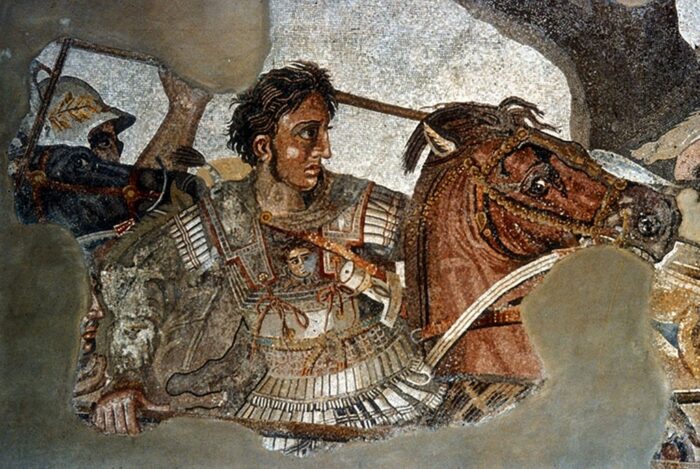Art can influence, represent, create and even distort memories…
The Pompeii Alexander Mosaic–a masterpiece of the ancient world. The immense detail and understanding of artistic style is apparent in the mosaic. The origins of this mosaic are often linked to ancient Greek wall paintings that came before the mosaic. It is thought to be a mosaic replica of what the wall painted once looked like. The original mosaic was tiled into the floor of the House of Faun in Pompeii. The scene depicted through an amazing work of tiles laid down in opus vermiculatum style is thought to represent the Battle of Issus. During the Battle of Issus, Alexander the Great managed to defeat King Darius III and the Persian Army. The scene shows Alexander’s immense strength and confidence upon the point of Persian defeat. Alexander seems to be purposefully portrayed as a confident character in this battle. The artist rendered him in this way most likely upon his request for art work to be made as a form of propaganda during his rule. This was one of the prime ways Alexander was able to spread his influence and empire successfully.
The Product:
I was able to create a digitized mosaic replicating the Alexander Mosaic. As the mosaic itself is thought to be a replica of an Ancient Greek painting, my artwork is a replica of the mosaic. I focused on the area of the mosaic in which Alexander is represented instead of taking on the whole intricate mosaic. Rather than using small tiles to mosaic this piece, I digitally mosaicked together individual photographs.

Click here for my mosaic piece, digitally generated using my own photographs of landscapes. Zoom in anywhere on the piece to view the individual images.
The Photographs:
My art work utilized 25 photographs I have taken from my natural surroundings both at Colgate, my hometown of Scituate, Massachusetts and other beautiful landscapes I have visited in the eastern United States. Alexander the Great utilized art work to generate a positive, strong representation of his military power and empire. Similarly, I want to demonstrate the spread I have had across the eastern US through my travels. Click anywhere on the mosaic to view a specific image that has been compiled to form my mosaic.
The Colors:
Mosaics rely heavily on different color stones to form the figures and shapes being represented. A variety of colors and shades of colors help to bring the mosaic alive. Although I wasn’t able to create my own stone mosaic, I found a way to represent the hard work that goes into finding precise colors to fit a mosaic. After creating my memory mosaic, I was able to explore the importance of color in the world around me. Specifically, I looked into how many colors would be required in order to create a fine tuned representation of Alexander’s head. The original mosaic utilized 25 photos of various coloration to achieve the mosaic’s desired image. I played around with different colors In my everyday environment to see just how many it takes to compose a singular section of a mosaic image. After finding many solid colors in my environment, I photographed them and used the same digital software to create the head.
Click here for the mosaic created from 25 colors I see everyday
Memorialization and Impact:
The artwork created during Alexander’s reign had a strong impact on the memory of him as a ruler. However, my photographs of the areas I have inhabited/visited represent my own memories of my travels and good times. There is a definite connection between my modern mosaic and the ancient mosaic under the theme of artistic style as a means to communicate messages or memories. Additionally, I was able to further my knowledge on the creation of ancient mosaics and the role color plays in creating an elegant mosaic.
***
Kelly Kowenhoven is part of the Colgate University Class of 2026. Currently undecided, she plans on majoring in Environmental Studies with a minor in Geography. She has discovered a newfound fascination with art history over the past semester–this final project draws on the knowledge she collected this semester.
